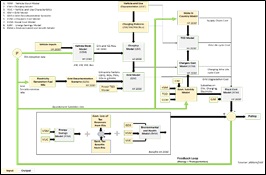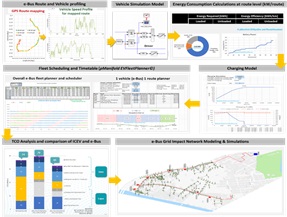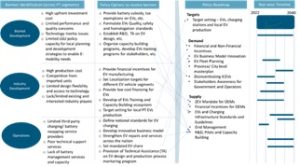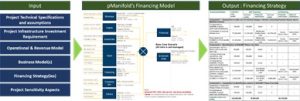In-house Tools and Frameworks developed for e-Mobility consulting projects

- The different CAPEX and OPEX costs are annualized (i.e., adjusted to reflect a value on an annual basis) to arrive at total yearly cost, which is then used to derive TCO per km. The TCO analysis also considers existing government incentives to EVs (example: subsidy of 3,200 USD to e-Bus operators).
- Battery replacement cost is accounted depending on battery life for each vehicle segment.
- Specific inputs required for TCO calculation of ICEV: Average vehicle efficiency, average run/ day, vehicle life, interest rate, operational days per year, etc.


- Route duty cycle development
- EV Energy consumption analysis
- Battery types & size design
- Charger types & size design
- Charging strategy design
- Grid ancillaries design
- Grid impact analysis
- EV operations and fleet scheduling
- TCO analysis
- GHG emissions saving

- EV adoption Barrier Analysis for market development, industry development and operations (Barriers mapping under 8 categories -Technological, Economical & Financial, Institutional, Infrastructure, Social, Market, Regulatory and Policy barriers)
- Barrier resolution through strategies and policies development that help create an enabling environment to address the barriers
- Policy Roadmap development including Targets, demand side measurea and supply side measures for EV adoption
- Action plan for implementation with short-, medium- and long-term scheduling

- Capex and Opex costs
- Cashflow Analysis
- Impact Assessment
- Loan Calculator
- Sensitivity Analysis
- TCO Framework
- Integrated Energy & Transport e-Mobility Model (IETEM©)
- EV Fleet Planner
- Policy Development Framework
- Project Financing Model
 The Total Cost of Ownership (TCO) analysis helps to understand the different cost elements across the life cycle of vehicle including various capital costs, taxations, and operational costs. It offers more accurate assessment of the economic efficiency of an electric vehicle (EV) over Internal Combustion Engine vehicle (ICEV). The methodology used for the analysis is shown in figure.
The Total Cost of Ownership (TCO) analysis helps to understand the different cost elements across the life cycle of vehicle including various capital costs, taxations, and operational costs. It offers more accurate assessment of the economic efficiency of an electric vehicle (EV) over Internal Combustion Engine vehicle (ICEV). The methodology used for the analysis is shown in figure.
- The different CAPEX and OPEX costs are annualized (i.e., adjusted to reflect a value on an annual basis) to arrive at total yearly cost, which is then used to derive TCO per km. The TCO analysis also considers existing government incentives to EVs (example: subsidy of 3,200 USD to e-Bus operators).
- Battery replacement cost is accounted depending on battery life for each vehicle segment.
- Specific inputs required for TCO calculation of ICEV: Average vehicle efficiency, average run/ day, vehicle life, interest rate, operational days per year, etc.
 It is a library of EV models. This library of models allows projecting macro and micro trends of e-Mobility over years and assess its impact on grid, environment, and Government budget. The model is tested and applied to develop quantitative road maps for multiple developing countries including Philippines, Maldives, Bhutan, India, and others. It covers, EVs growth projections (different segments), Charging infra requirements, Grid Impact, Grid upgradation requirements, Grid energy mix planning, GHG estimation, Health impact estimation, TCO analysis, Govt. budget & fiscal incentives planning
It is a library of EV models. This library of models allows projecting macro and micro trends of e-Mobility over years and assess its impact on grid, environment, and Government budget. The model is tested and applied to develop quantitative road maps for multiple developing countries including Philippines, Maldives, Bhutan, India, and others. It covers, EVs growth projections (different segments), Charging infra requirements, Grid Impact, Grid upgradation requirements, Grid energy mix planning, GHG estimation, Health impact estimation, TCO analysis, Govt. budget & fiscal incentives planning
 EV Fleet Planner © is a SCILAB and excel based tool developed for systematic e-Bus fleet planning including framework for comprehensive network planning and fleet scheduling. It covers,
EV Fleet Planner © is a SCILAB and excel based tool developed for systematic e-Bus fleet planning including framework for comprehensive network planning and fleet scheduling. It covers,
- Route duty cycle development
- EV Energy consumption analysis
- Battery types & size design
- Charger types & size design
- Charging strategy design
- Grid ancillaries design
- Grid impact analysis
- EV operations and fleet scheduling
- TCO analysis
- GHG emissions saving
 This framework is a combined approach of top-down policy design using IETEM© modeling and bottom-up city/regional level EV industry assessment for country level EV adoption plan and roadmap. It covers,
This framework is a combined approach of top-down policy design using IETEM© modeling and bottom-up city/regional level EV industry assessment for country level EV adoption plan and roadmap. It covers,
- EV adoption Barrier Analysis for market development, industry development and operations (Barriers mapping under 8 categories -Technological, Economical & Financial, Institutional, Infrastructure, Social, Market, Regulatory and Policy barriers)
- Barrier resolution through strategies and policies development that help create an enabling environment to address the barriers
- Policy Roadmap development including Targets, demand side measurea and supply side measures for EV adoption
- Action plan for implementation with short-, medium- and long-term scheduling
 It has been developed for financial and economical assessment of infrastructure projects and developing right financing strategy. It covers,
It has been developed for financial and economical assessment of infrastructure projects and developing right financing strategy. It covers,
- Capex and Opex costs
- Cashflow Analysis
- Impact Assessment
- Loan Calculator
- Sensitivity Analysis
Economic and Financial model
- TCO Framework
- Integrated Energy & Transport e-Mobility Model (IETEM©)
- EV Fleet Planner
- Policy Development Framework
- Project Financing Model
 The Total Cost of Ownership (TCO) analysis helps to understand the different cost elements across the life cycle of vehicle including various capital costs, taxations, and operational costs. It offers more accurate assessment of the economic efficiency of an electric vehicle (EV) over Internal Combustion Engine vehicle (ICEV). The methodology used for the analysis is shown in figure.
The Total Cost of Ownership (TCO) analysis helps to understand the different cost elements across the life cycle of vehicle including various capital costs, taxations, and operational costs. It offers more accurate assessment of the economic efficiency of an electric vehicle (EV) over Internal Combustion Engine vehicle (ICEV). The methodology used for the analysis is shown in figure.
- The different CAPEX and OPEX costs are annualized (i.e., adjusted to reflect a value on an annual basis) to arrive at total yearly cost, which is then used to derive TCO per km. The TCO analysis also considers existing government incentives to EVs (example: subsidy of 3,200 USD to e-Bus operators).
- Battery replacement cost is accounted depending on battery life for each vehicle segment.
- Specific inputs required for TCO calculation of ICEV: Average vehicle efficiency, average run/ day, vehicle life, interest rate, operational days per year, etc.
 It is a library of EV models. This library of models allows projecting macro and micro trends of e-Mobility over years and assess its impact on grid, environment, and Government budget. The model is tested and applied to develop quantitative road maps for multiple developing countries including Philippines, Maldives, Bhutan, India, and others. It covers, EVs growth projections (different segments), Charging infra requirements, Grid Impact, Grid upgradation requirements, Grid energy mix planning, GHG estimation, Health impact estimation, TCO analysis, Govt. budget & fiscal incentives planning
It is a library of EV models. This library of models allows projecting macro and micro trends of e-Mobility over years and assess its impact on grid, environment, and Government budget. The model is tested and applied to develop quantitative road maps for multiple developing countries including Philippines, Maldives, Bhutan, India, and others. It covers, EVs growth projections (different segments), Charging infra requirements, Grid Impact, Grid upgradation requirements, Grid energy mix planning, GHG estimation, Health impact estimation, TCO analysis, Govt. budget & fiscal incentives planning
 EV Fleet Planner © is a SCILAB and excel based tool developed for systematic e-Bus fleet planning including framework for comprehensive network planning and fleet scheduling. It covers,
EV Fleet Planner © is a SCILAB and excel based tool developed for systematic e-Bus fleet planning including framework for comprehensive network planning and fleet scheduling. It covers,
- Route duty cycle development
- EV Energy consumption analysis
- Battery types & size design
- Charger types & size design
- Charging strategy design
- Grid ancillaries design
- Grid impact analysis
- EV operations and fleet scheduling
- TCO analysis
- GHG emissions saving
 This framework is a combined approach of top-down policy design using IETEM© modeling and bottom-up city/regional level EV industry assessment for country level EV adoption plan and roadmap. It covers,
This framework is a combined approach of top-down policy design using IETEM© modeling and bottom-up city/regional level EV industry assessment for country level EV adoption plan and roadmap. It covers,
- EV adoption Barrier Analysis for market development, industry development and operations (Barriers mapping under 8 categories -Technological, Economical & Financial, Institutional, Infrastructure, Social, Market, Regulatory and Policy barriers)
- Barrier resolution through strategies and policies development that help create an enabling environment to address the barriers
- Policy Roadmap development including Targets, demand side measurea and supply side measures for EV adoption
- Action plan for implementation with short-, medium- and long-term scheduling
 It has been developed for financial and economical assessment of infrastructure projects and developing right financing strategy. It covers,
It has been developed for financial and economical assessment of infrastructure projects and developing right financing strategy. It covers,
- Capex and Opex costs
- Cashflow Analysis
- Impact Assessment
- Loan Calculator
- Sensitivity Analysis
Economic and Financial model


